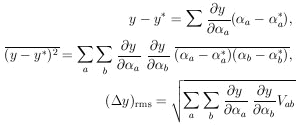


Consider the case in which a single physical quantity, y,
is some function of the  's:
y = y(
's:
y = y( 1, ...,
1, ...,
 M). The "best"
value for y is then y* =
y(
M). The "best"
value for y is then y* =
y( i*).
For example y could be the path
radius of an electron circling in a uniform magnetic field where
the measured quantities are
i*).
For example y could be the path
radius of an electron circling in a uniform magnetic field where
the measured quantities are
 1 =
1 =
 , the period of revolution,
and
, the period of revolution,
and
 2 = v, the
electron velocity. Our goal is to find the
error in y given the errors in
2 = v, the
electron velocity. Our goal is to find the
error in y given the errors in
 . To first order in
(
. To first order in
( i -
i -
 i*) we have
i*) we have

| (12) |
A well-known special case of Eq. (12), which holds only when the variables are completely uncorrelated, is

|
In the example of orbit radius in terms of
 and v this becomes
and v this becomes

|
in the case of uncorrelated errors. However, if
 is
non-zero as one might expect, then Eq. (12) gives
is
non-zero as one might expect, then Eq. (12) gives

|
It is a common problem to be interested in M physical parameters,
y1, ..., yM, which are known
functions of the
 i.
In fact the yi can be thought of as a new set of
i.
In fact the yi can be thought of as a new set of
 i or a
change of basis from
i or a
change of basis from
 i to
yi. If the error matrix of the
i to
yi. If the error matrix of the
 i
is known, then we have
i
is known, then we have

| (13) |
In some such cases the ðyi /
ð a cannot be
obtained directly, but the
ð
a cannot be
obtained directly, but the
ð i /
ðya are easily
obtainable. Then
i /
ðya are easily
obtainable. Then

|
Example 3
Suppose one wishes to use radius and acceleration to
specify the circular orbit of an electron in a uniform magnetic
field; i.e., y1 = r and y2 =
a. Suppose the original measured quantities are
 1 =
1 =
 = (10 ± 1)µs and
= (10 ± 1)µs and
 2 = v =
(100 ± 2) km/s. Also
since the velocity measurement depended on the time measurement,
there was a correlated error
2 = v =
(100 ± 2) km/s. Also
since the velocity measurement depended on the time measurement,
there was a correlated error
 = 1.5 × 10-3
m. Find
r,
= 1.5 × 10-3
m. Find
r, r, a,
r, a,
 a.
a.
Since r = v /
2
/
2 = 0.159 m and
a = 2
= 0.159 m and
a = 2 v /
v /
 = 6.28 × 1010
m/s2 we have y1 =
= 6.28 × 1010
m/s2 we have y1 =
 1
1 2 /
2
2 /
2 and
y2 = 2
and
y2 = 2
 2 /
2 /
 1. Then
ðy1 /
ð
1. Then
ðy1 /
ð 1 =
1 =
 2 /
2
2 /
2 ,
ðy1 /
ð
,
ðy1 /
ð 2 =
2 =
 1 /
2
1 /
2 ,
ðy2 /
ð
,
ðy2 /
ð 1 =
-2
1 =
-2
 2 /
2 /
 12,
ðy2 /
ð
12,
ðy2 /
ð 2 =
2
2 =
2 /
/
 1 . The
measurement errors specify the error matrix as
1 . The
measurement errors specify the error matrix as

|
Eq. 13 gives

|
Thus r = (0.159 ± 0.184) m
For y2, Eq. 13 gives

|
Thus a = (6.28 ± 0.54) × 1010 m/s2.